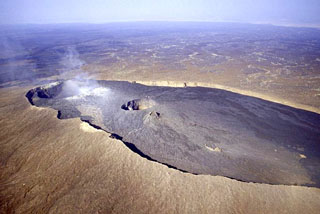Report on Erta Ale (Ethiopia) — 25 January-31 January 2017
Smithsonian Institution / US Geological Survey
Weekly Volcanic Activity Report, 25 January-31 January 2017
Managing Editor: Sally Sennert.
Please cite this report as:
Global Volcanism Program, 2017. Report on Erta Ale (Ethiopia) (Sennert, S, ed.). Weekly Volcanic Activity Report, 25 January-31 January 2017. Smithsonian Institution and US Geological Survey.
Erta Ale
Ethiopia
13.601°N, 40.666°E; summit elev. 585 m
All times are local (unless otherwise noted)
According to Volcano Discovery, visitors noted changes at Erta Ale’s lava lake during 16-20 January characterized by waves in the lava lake, intense spattering, fountaining, and rim overflows (mainly on 17 January) which traveled as far as 1 km. During the evening of 20 January explosions of very large gas bubbles ejected spatter 30 m high. Crater rim collapses affected the N crater where a new oval-shaped pit crater (150 x 30 m and 20 m depth) formed during a 24-hour period. A large collapse also occurred in the S part of the crater. The activity was accompanied by ash emissions that rose as high as 800 m. The report noted that on 21 January new fissures opened SSE from the summit caldera, producing large amounts of lava.
Satellite images acquired and processed by Planet Labs showed the new lava flows and gas-and-steam emissions from several vents (about 1.5 km SE from the overflow area at the SE caldera rim) on 23 January, and more new lava flows on 27 January. Both images showed lava flows advancing WSW, about 2.5 km S, and about 3 km NE. According to NASA's Earth Observatory, a satellite image acquired on 26 January showed two distinct infrared hotspots representing the SE lava flows. On 27 January Simon Carn stated that the eruption produced the largest SO2 emissions from Erta Ale ever measured from space.
Geological Summary. The Erta Ale basaltic shield volcano in Ethiopia has a 50-km-wide edifice that rises more than 600 m from below sea level in the Danakil depression. The volcano includes a 0.7 x 1.6 km summit crater hosting steep-sided pit craters. Another larger 1.8 x 3.1 km wide depression elongated parallel to the trend of the Erta Ale range is located SE of the summit and is bounded by curvilinear fault scarps on the SE side. Basaltic lava flows from these fissures have poured into the caldera and locally overflowed its rim. The summit caldera usually also holds at least one long-term lava lake that has been active since at least 1967, and possibly since 1906. Recent fissure eruptions have occurred on the N flank.
Sources: NASA Earth Observatory, Volcano Discovery, Simon Carn, Planet Labs

